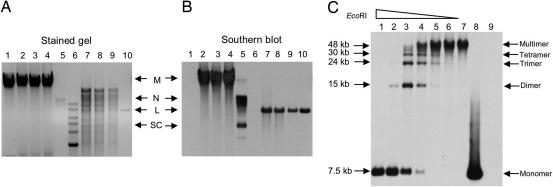Fig. 2.
Replication products of SaPIbov1 pri-rep-ori subclone. (A) Total DNA from bacterial cultures was extracted and separated by agarose gel electrophoresis (lanes 1–4) or was initially digested with EcoRI, which cuts once in the plasmid (lanes 7–9). Lane 1, RN4220; lanes 2–4 and 7–9 correspond to three EmR transformants obtained in RN4220 with the SaPIbov1 pri-rep-ori subclone (pRN9211); lane 5 corresponds to the plasmid pRN9211 extracted from E. coli strain DH5α; lane 10, same plasmid DNA as lane 5 previously digested with EcoRI; lane 6, DNA ladder. (B) The same gel probed with a pRN9211-specific probe. The locations of multimers (M), nicked circular monomers (N), linear monomers (L), and supercoiled monomers (SC) are indicated. (C) Whole-cell DNA isolated from one pri-rep-ori transformant, digested with diminishing amounts of EcoRI (lanes 1–6) or undigested (lane 7), was separated by agarose gel electrophoresis, then Southern blotted as in B. Lane 8, plasmid pRN9211 extracted from E. coli and digested with EcoRI; lane 9, RN4220 DNA digested with EcoRI.

